Littleton School District No. 6 (Littleton Public Schools)
When the Pikes Peakers began flooding into the South Platte valley in 1859, they did not leave civilization behind in the East. Nor did they leave their families. Housed in a leaky log cabin in Denver City, Colorado's first school was opened by O.J. Goldrick in October 1859 for fifteen students at a tuition of $3.00 each per month. This Denver Union School was joined in 1860 by second school in Boulder and others in Denver. All the schools were privately owned and operated, as no provision was made for government support until 1862, when School Districts #1 and #2 were established in east and west Denver, respectively.
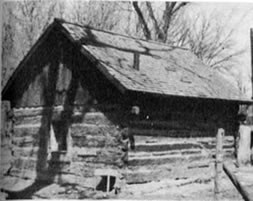
Littleton's first schoolhouse built in 1865 by John Bell for $65. Date unknown.
Settlers in the area that would become Littleton began classes in 1864, and informally perhaps as early as 1860 in the home of Isaac McBroom. In 1864, however, a number of settlers met at Richard Little's cabin to organize what would become School District #6, also known as the Littleton School District. The boundaries extended from the Denver city limits in the north to the Arapahoe/Douglas County line in the south, from Sheridan Boulevard in the west to the Kansas border in the east. L.B. Ames was elected president, R.T. Hussy, secretary and R.S. Little, treasurer. For one year, classes met in Little's cabin.
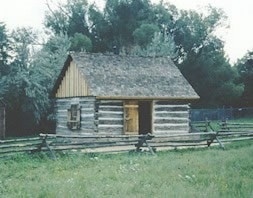
Littleton's first schoolhouse, now sits on the Littleton Historical Museum grounds.
In 1865, Harry Pickard donated land for a schoolhouse, and at a cost of $65 a one-room log structure was built by John Bell on present-day Union Avenue just east of the South Platte River, about a mile and a half north of downtown Littleton. The building measured about 16 feet by 17 feet with a single-slope lumber roof covered with sod. The interior was furnished with rough tables and long benches made of pine for the students, a small desk and chair for the teacher and was heated by a box stove. The first teacher was L.B. Ames, who was paid $40 per month during 1866-1867 to teach fifteen pupils. The following year his wife was paid $50 and had but three students. The reason for the drop in enrollment was that Littleton's first frame schoolhouse had opened on the Lilley ranch on the west side of the South Platte River.
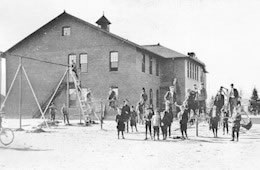
Rapp Street School, c.1911.
Littleton's first brick school was opened in 1873 at Rapp and Church Streets on land donated by Richard Little. Enrollment soon reached seventy students. There followed a two-story addition to the "Rapp Street School" in 1883, and finally another expansion replacing the original one-story building in 1904. This school served grades one through twelve until 1920, when the secondary grades moved to Grant School, and then continued as a grade school until torn down in 1953. In 1889, Littleton School District #6 was formally incorporated. Edwin A. Bemis, former editor and owner of the Littleton Independent newspaper, wrote about an incident that happened at the Rapp Street School: "A group of young fellows went to the school house at Rapp and Church Streets, climbed the building and removed the school bell. In doing this, they tore down eaves, piping, lightning rods and other parts of the building; then they took the bell to the Mill Race on Church Street and threw it in the water. History does not tell us how the town police and school authorities found out who did it, but apparently they did learn the names of the perpetrators who were forced to go to the Mill Race and dive for the bell, bring it back, and replace it in the school belfry."
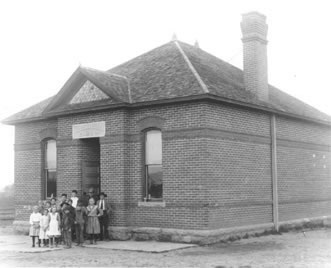
Broadway School, c.1903.
In 1894, a second school was built at the intersection of Broadway and Littleton Boulevard. The "Broadway School" was meant to serve families in the eastern part of the county for whom the Rapp School was too distant. School District enrollment in the 1890s reached 222, although average daily attendance was only 153. The faculty climbed from one to three in 1883 with the expansion of the Rapp School and rose to eight "first-class instructors" when the Broadway School opened. The Grant Street High School was completed in 1920, at a cost of $100,000. This, in turn, was replaced by the current Littleton High School in 1956, and in 1985 the Grant Street School became the District's Education Services Center.
Today, Littleton School District #6 (Littleton Public Schools) includes fourteen elementary schools, four middle schools, three high schools, two charter schools, The Village Preschool at Highland and North, and a number of alternative programs. The original one-room log schoolhouse still stands. When the Rapp Street School opened in 1873, the log school ceased regular operation. Sometime before 1900 it was moved to the Sam Brown ranch west of the river. In 1951, it was donated to the city and moved to Rio Grande Park (Bega Park). Finally in 1972 it was moved to its current location at the Littleton Museum, where it is again used to teach visitors the three R's, 1865-style.
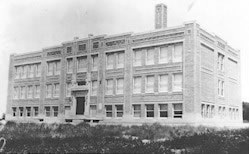
Old Littleton High School, later Grant Jr. High. Date unknown.
A $298 million bond measure was approved by voters in November, 2018 and improved a number of the district's buildings. Several elementary schools were rebuilt or retooled and the district developed a career and technical education center where students can learn vocational skills. Grass fields were replaced with durable turf fields at middle and high schools. Highland Elementary School is being transformed into the home of the LPS Early Childhood Center. In addition, a new stadium and school building will open on the Newton Middle School campus in 2021. School start times changed in 2018-19 to better align with adolescent sleep patterns.
On October 12, 2021, the District celebrated the official groundbreaking of the new Career Exploration Center, located at the southeast corner of Broadway and Littleton Boulevard in Littleton. The Center will provide innovative programming for six career pathways: aerospace, business and entrepreneurship, computer science, construction trades, healthcare, and natural resources. More career pathways will be added in the future. Opportunities for concurrent enrollment and dual high school credit are being explored through LPS's partnerships with Arapahoe Community College and local businesses. The Center is projected to open for students in the fall of 2023.
On March 30, 2021 the Littleton School Board announced that East and Moody elementary schools would be consolidated into a new building on the Moody Elementary campus, located at Windermere Street and Weaver Avenue in Littleton. Plans are for the new school to open by fall 2023. Both Moody and East Elementary Schools had fallen below 300 students in recent years.
Under a plan adopted by the Littleton School Board on April 8, 2021, Peabody and Twain Elementary Schools will close due to declining enrollment. The two student bodies will be absorbed by nearby schools starting in the fall of 2022. Students from Peabody will consolidate with Lenski Elementary School. Students from Twain will be absorbed into a new school that will be built on the Franklin Elementary campus. Students from Highland Elementary will also be absorbed into Franklin Elementary School beginning in 2022.
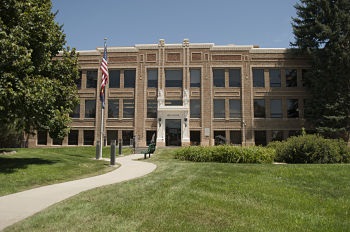
Littleton School District Administration Building (old Littleton High School), 2015. Photo by Amelia Martinez.
Additional information on: Littleton Public Schools Website
Bibliography
Bemis, Edwin A. Historical Notes. Littleton, Colorado. Date unknown.
Friesen, Steve. A History of Littleton's First School House and School District. Littleton: Littleton History Museum, 1979.
Littleton Independent. Littleton Independent Publishers, 1888-
Littleton Museum. Photographic Archives.
____. Vertical File: "Schools".
Littleton Public Schools. Centennial History, 1890-1990. Littleton: Littleton Public Schools, 1990.
McQuarie, Robert J. and C.W. Buchholtz. Littleton, Colorado: Settlement to Centennial. Littleton: Littleton Historical Museum and Friends of the Library and Museum, 1990.
Photographs courtesy of the Littleton Museum, unless otherwise noted; to order copies, contact the Museum at 303-795-3950.
Compiled by Pat Massengill
Updated December 2021 by Phyllis Larison